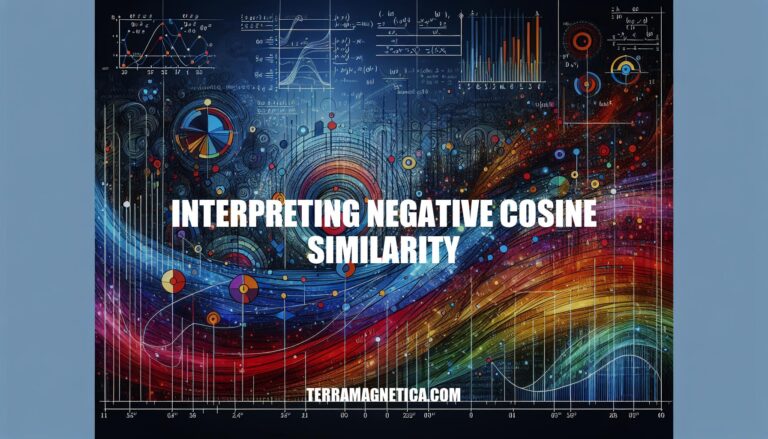


Negative cosine similarity measures the angle between two vectors, indicating how dissimilar they are. A value close to -1 suggests the vectors point in opposite directions. This metric is significant in fields like natural language processing for understanding semantic differences, recommendation systems to identify contrasting preferences, and information retrieval to filter out irrelevant results.
Negative cosine similarity measures the dissimilarity between two vectors. It is calculated as the cosine of the angle between the vectors, resulting in a value between -1 and 1. A value of -1 indicates that the vectors point in exactly opposite directions, representing maximum dissimilarity.
In vector analysis, this metric helps identify how distinct two vectors are from each other, with negative values highlighting strong dissimilarity.
Cosine Similarity Formula:
where:
Negative Cosine Similarity:
Example Calculation:
Given vectors (\vec{a} = [1, 5]) and (\vec{b} = [-1, 3]):
Dot Product:
Magnitudes:
Cosine Similarity:
In this example, the cosine similarity is positive, indicating the vectors are somewhat similar. For a negative cosine similarity, the dot product would need to be negative, indicating a larger angle between the vectors.
In sentiment analysis, cosine similarity measures the angle between two vectors representing text data. When the cosine similarity is negative, it indicates that the vectors are pointing in opposite directions. This is crucial for differentiating between positive and negative sentiments because:
Here are some specific use cases of interpreting negative cosine similarity in text mining:
Document Clustering:
Topic Modeling:
These use cases leverage negative cosine similarity to enhance the precision and effectiveness of text mining tasks.
Here are the challenges and limitations associated with interpreting negative cosine similarity:
Misinterpretation of Negative Values: Negative cosine similarity can be misunderstood as indicating a strong dissimilarity, whereas it actually signifies that the vectors are pointing in opposite directions.
Magnitude Ignorance: Cosine similarity focuses on the angle between vectors, ignoring their magnitudes. This can lead to misleading interpretations when comparing documents of varying lengths.
Sensitivity to Sparse Data: In high-dimensional spaces with sparse data, negative cosine similarity might not accurately reflect true dissimilarity due to the presence of many zero values.
Context Loss: It does not account for the order or position of words, which can be crucial in understanding the context, especially in short texts.
Scalability Issues: As document length increases, the complexity of the text also increases, making cosine similarity less effective in capturing nuanced semantic relationships.
Common Misconceptions: A common misconception is that negative cosine similarity always indicates a poor match, while it might just reflect different but equally valid perspectives.
Negative cosine similarity is a crucial concept in text mining that measures the angle between two vectors representing text data. When the cosine similarity is negative, it indicates that the vectors are pointing in opposite directions, which can be useful for differentiating between positive and negative sentiments. This is particularly important in sentiment analysis as it helps algorithms accurately classify texts into positive or negative categories.
In document clustering, negative cosine similarity can help identify outliers or documents that are significantly different from the main clusters. It can also aid in refining cluster assignments by re-evaluating documents with negative cosine similarity to cluster centroids.
In topic modeling, negative cosine similarity highlights documents strongly associated with different topics, helping distinguish between topics that might otherwise seem similar. It also aids in model validation by examining documents with negative cosine similarity to topic vectors.
However, interpreting negative cosine similarity comes with challenges and limitations. Misinterpreting negative values can lead to misunderstanding the strength of dissimilarity, while ignoring magnitudes can result in misleading interpretations when comparing documents of varying lengths. Additionally, sensitivity to sparse data and context loss can affect its accuracy, and scalability issues may arise as document length increases.
Despite these challenges, negative cosine similarity remains a valuable tool for text mining tasks, particularly in sentiment analysis and topic modeling. Its importance lies in its ability to capture nuanced semantic relationships between texts, making it an essential concept for researchers and practitioners working with text data.